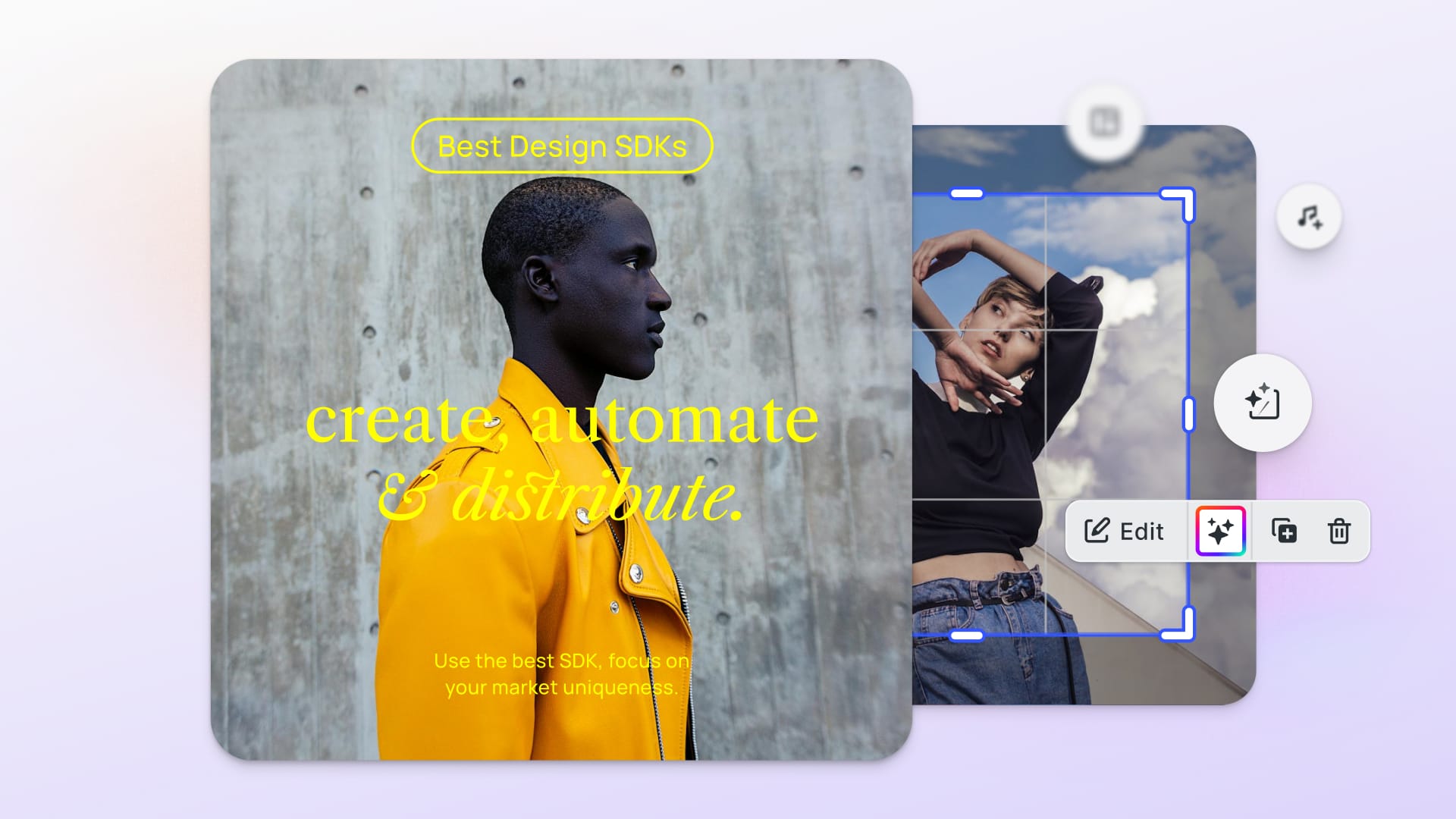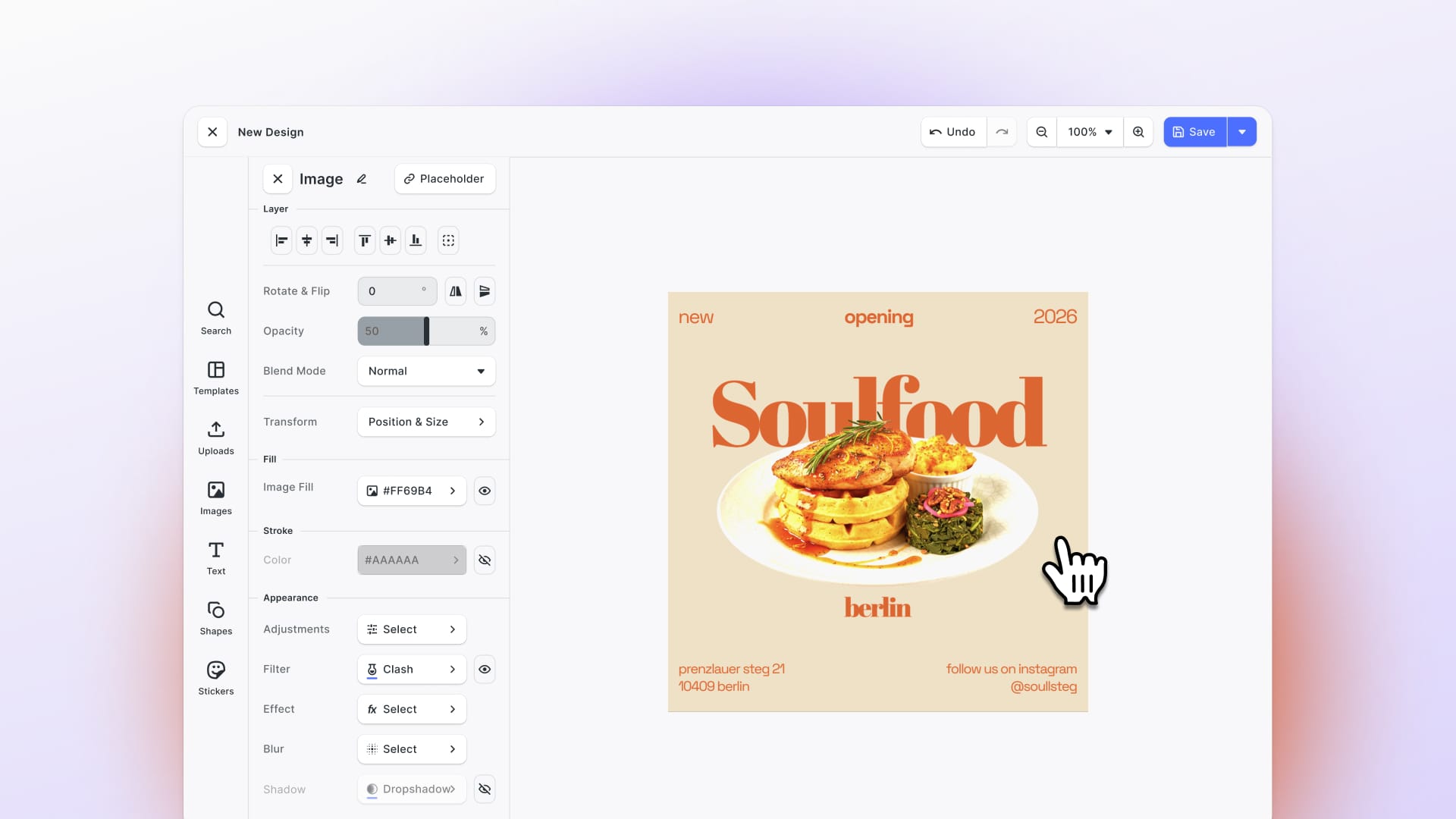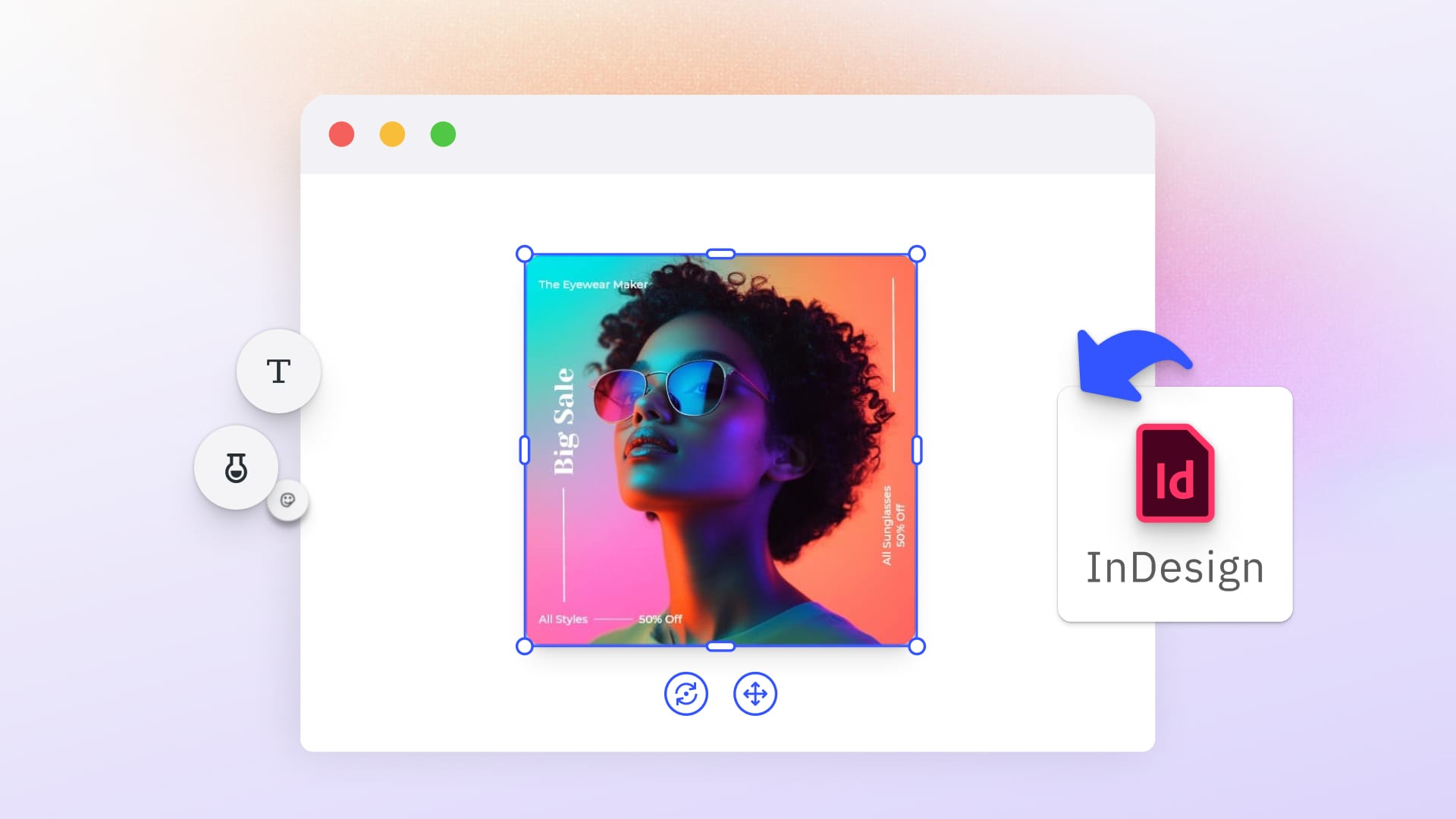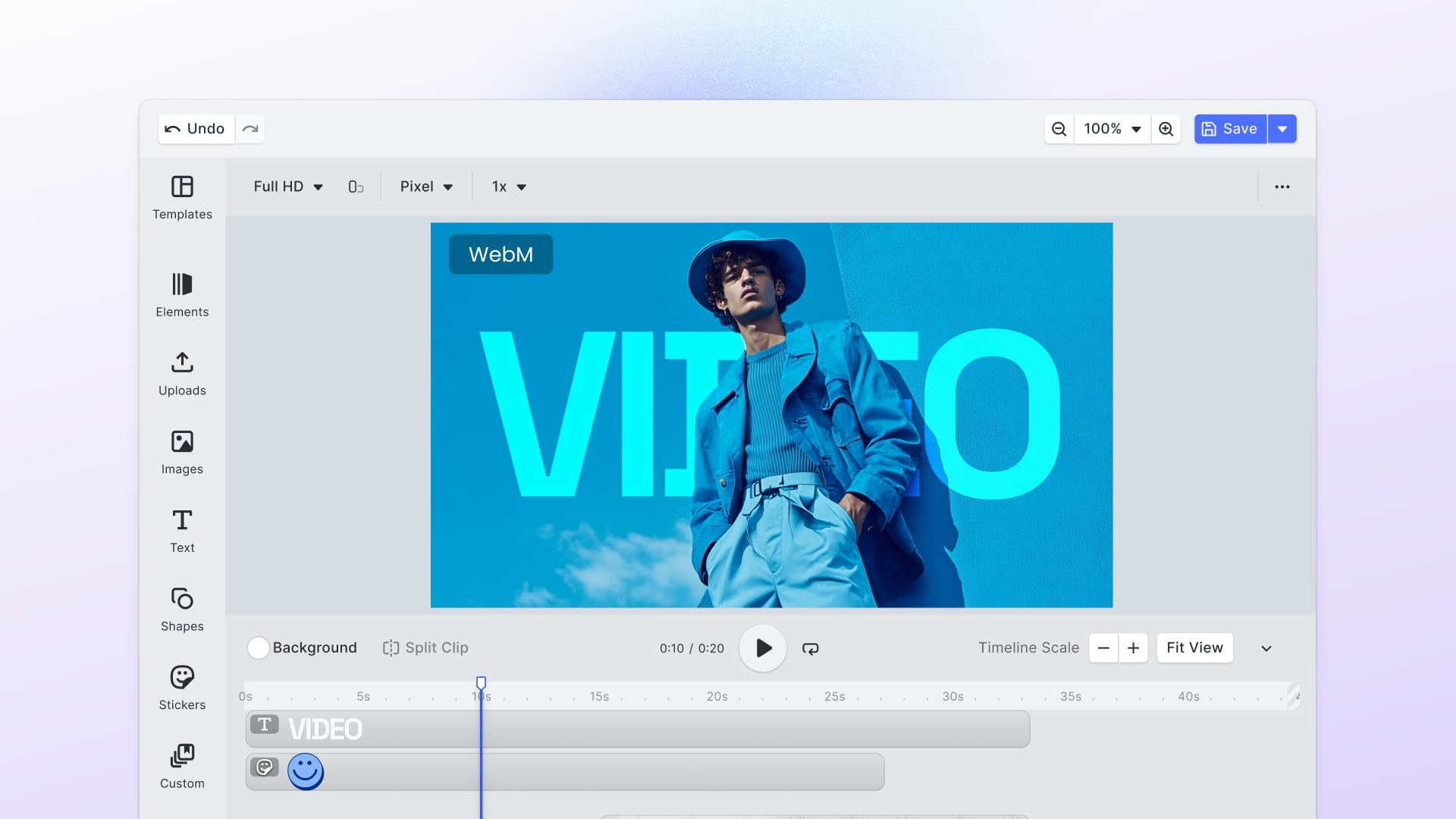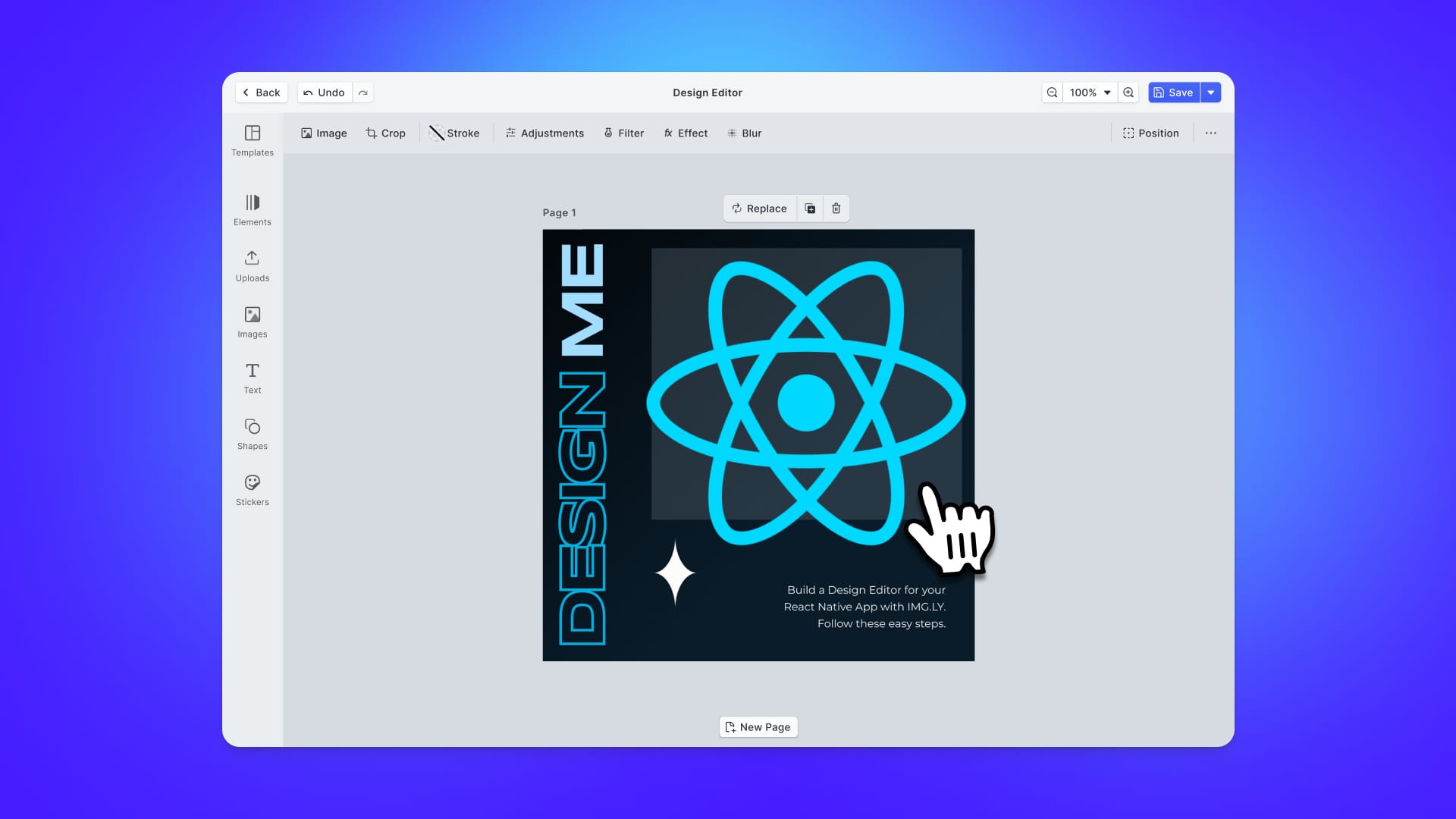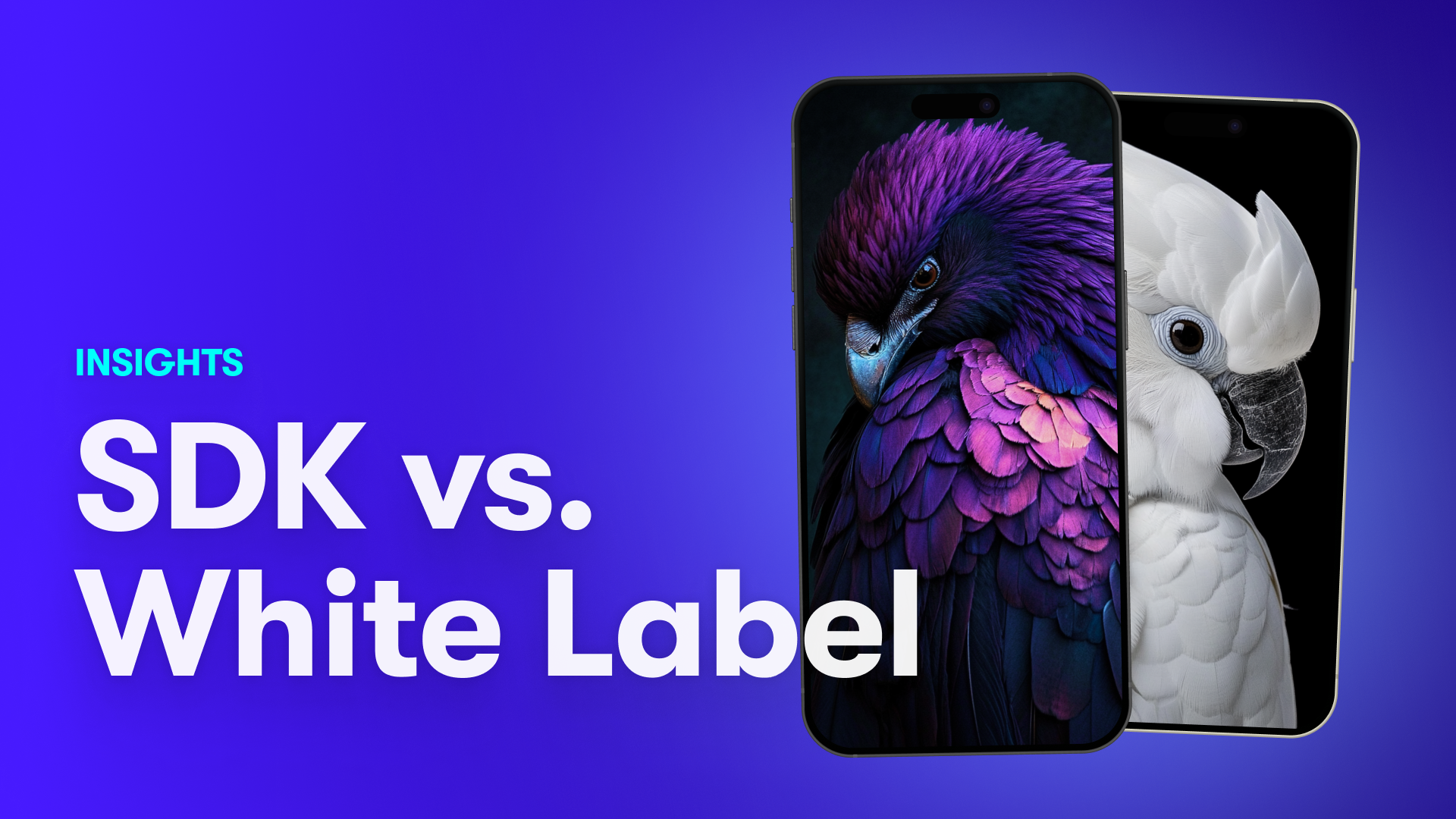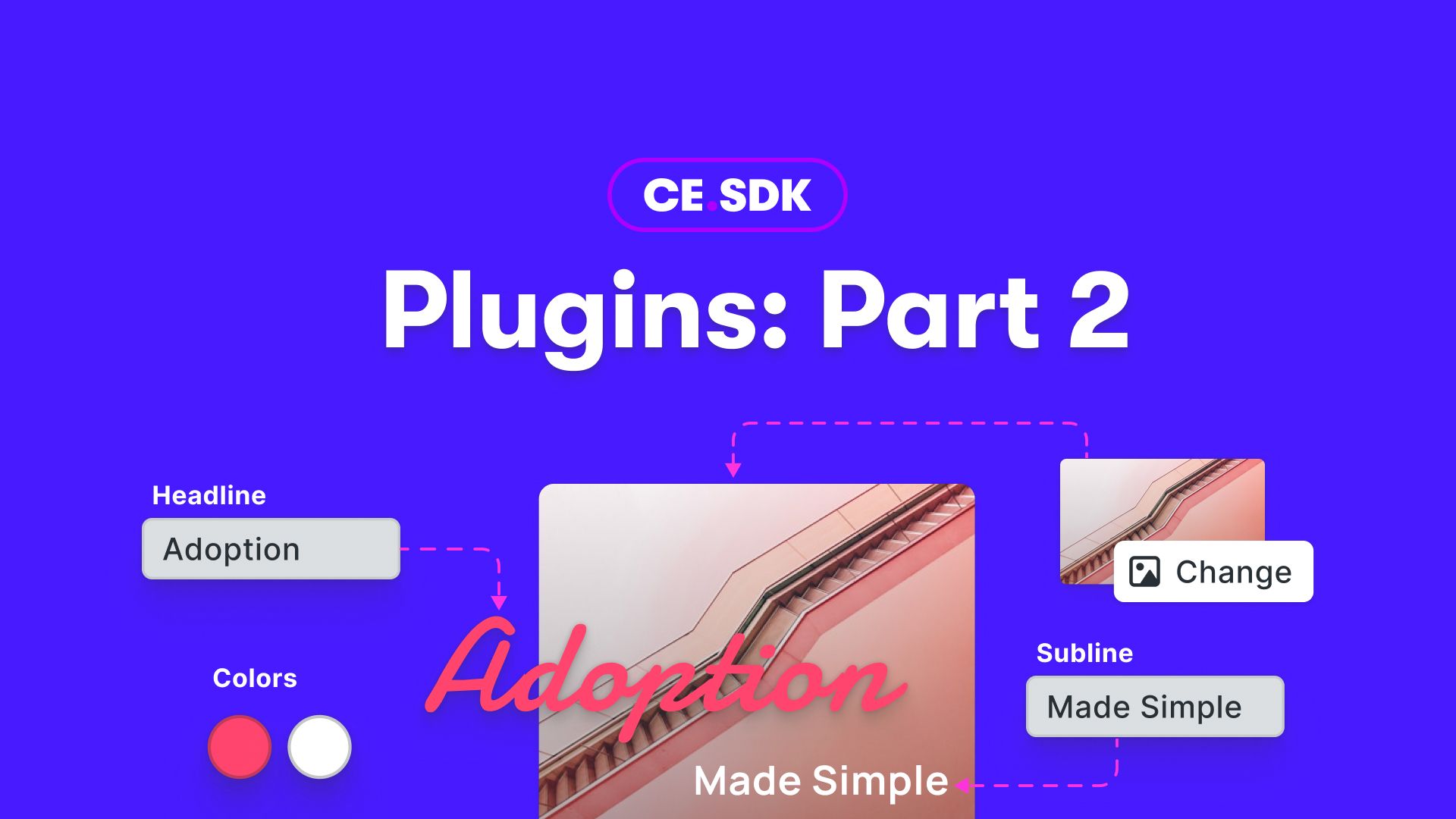Choosing the right design editor SDK can define how your product handles content creation. The wrong choice may limit your growth, while the right one can unlock scalable workflows, better user experience, and faster time to market.
We’ll look at their strengths, limitations, and best-fit scenarios, and explain why IMG.LY stands out as the best cross-platform design editor SDK for enterprises.
1. IMG.LY CreativeEditor SDK (CE.SDK)
CE.SDK is built for companies that need more than just basic image or video filters. It’s designed as an enterprise-grade editing platform covering both creative UI for end users and backend automation workflows. It supports photo, video, and template-based editing, so it can adapt as your product’s creative demands grow.
- Features & capabilities: With CE.SDK you get multi-layer editing, template systems you can feed dynamic content into, AI-powered tools like background removal or generative design, and a plugin ecosystem to extend what comes out of the box.
- Platforms & customization: CE.SDK runs on every platform: Web, iOS, Android, React Native, Flutter, Node.js, and Electron. This means whether you’re building a mobile app, a desktop dashboard, or a hybrid setup, the editor behaves consistently. On the customization side, everything is fully white-label. You can theme the UI, adapt workflows, and build custom plugins. It’s designed so your users feel like they’re interacting with your brand, not a third-party tool.
- Implementation: Implementation is designed to scale. You can get going quickly with default editors, then ramp up to more custom UX as needed. Because CE.SDK handles both the frontend editing tools and has engine APIs for automation (e.g., templating, rendering), teams don’t need to piece together separate tools for UI and backend workflows.
- Use cases: Some of the use cases include: E-commerce personalization, allowing customers to design or customize products, packaging, or visuals. For MarTech platforms, you can create campaign graphics, video ads, and templates. It's also perfect for social platforms, Digital Asset Management (DAM) systems, and SaaS apps that want rich media editing.
- Future‑proofing, support & pricing: IMG.LY ships frequent releases with cross‑platform parity and a clear AI roadmap. Support includes enterprise service-level agreements, onboarding support, and assistance for scaling. Pricing is custom, based on enterprise licensing. That means you pay for what you need.
- Who it's for: CE.SDK is ideal for organizations that need high customization and a white-label editor across platforms. Or companies that want both interactive user editing and automated creative workflows.
Key differentiator
CE.SDK sets itself apart by combining an interactive editor UX with a powerful automation stack in one SDK. It also brings AI features and cross‑platform coverage, making it the benchmark for enterprise‑grade design editing. If your company is expected to scale, CE.SDK will scale with you. And it's perfect if you care about brand consistency, UX polish, and want to avoid “bolting on” tools later.
Explore our case studies to see how companies in e‑commerce, MarTech, and SaaS have already adopted CE.SDK to scale their creative workflows.
2. Canva Connect API
Canva Connect API brings Canva’s editor and templates into other apps. It provides an integration layer that allows third-party platforms to embed Canva’s design environment without investing in building a native editor from scratch. This makes it an appealing choice for teams who want to add familiar design tools quickly, but it also means that the editing experience remains tied to Canva’s infrastructure and branding.
- Features & capabilities: With Canva Connect, your users get Canva’s large library of templates and assets, plus Canva’s editing tools and export options. This often means access to well-designed template content, background assets, and photo editing tools.
- Platforms & customization: It’s primarily a web-based API, and the actual editing experience is tied to the Canva ecosystem and branding. While this allows stability and ease of maintenance, it reduces the ability for organizations to adapt the editor to their own branding or workflows.
- Implementation & use cases: Implementation is relatively simple: connect via API and embed or redirect to Canva’s editor. It's beneficial for SaaS apps that want to allow users to design graphics without building an editor from scratch.
- Future-proofing, support & pricing: The API is tied to Canva’s roadmap, so the feature availability depends on how Canva evolves. Support is offered via documentation and community. The pricing is usage-based SaaS; you pay according to usage and the features you enable.
- Who it's for: Canva Connect API is most suitable for teams that want to provide template‑driven design capabilities with minimal development effort. It works well for organizations that are comfortable adopting Canva’s ecosystem and can accept the trade‑offs in branding and customization.
How it compares to IMG.LY
Compared to IMG.LY, Canva Connect provides significantly less control. With IMG.LY, you gain access to a fully white-label solution that allows you to theme and brand the interface, deploy across multiple platforms, and integrate advanced AI tools.
Canva Connect offers speed and convenience, but at the cost of design ownership, UI flexibility, and long-term control. For organizations prioritizing consistent user experience, platform coverage, and automation, IMG.LY remains the stronger choice.
Read more about how IMG.LY is a great alternative to Canva Connect here.
3. Placid Editor SDK
The Placid Editor allows you to embed a customizable editing experience of your templates directly into your application. Its primary strength lies in enabling organizations to deliver consistent, template-driven content creation without requiring significant development resources. By restricting edits to predefined fields and layouts it helps maintain brand integrity while still giving end users the flexibility to customize outputs.
- Features & capabilities: Placid provides a curated template system. You define branded templates and control which elements are editable. Users create consistent assets without risking layout integrity. Exports cover common image formats and simple video formats.
- Platforms & customization: Placid runs on the Web (JavaScript SDK). Customization centers on template configuration rather than deep UI theming or plugins. The tool is less about deep custom UI themes or plugins and more about giving non-designers safe, branded content creation workflows.
- Implementation & use cases: This SDK offers easy integration via CDN, and the setup tends to be fast. Some of the common use cases include marketing automation tools, campaign content creation, branded content platforms where consistency matters, and cases where development bandwidth is limited but design control is important.
- Future‑Proofing, support & pricing: Placid’s roadmap is largely centered on enhancing template management, expanding export options, and simplifying collaboration. Support is vendor‑driven and through documentation. Pricing follows a subscription model, usually linked to template volumes or usage tiers.
- Who it's for: Teams who need branded, template-driven editing, but don’t need advanced customization or deep video timelines. Placid is good for smaller teams, marketing departments, content creators, or SaaS tools focused on content campaigns rather than video editors.
How it compares to IMG.LY
To summarize, Placid is simpler and lighter. If you just need templates, safe editing, and minimal dev effort, Placid could get you up and running fast.
But compared to IMG.LY, you lose: multi-platform coverage, full white-label UI control, advanced video editing capability, deep automation, and AI features. If you expect your editing requirements to grow over time, IMG.LY gives more headroom to do so.
4. Design Huddle
Design Huddle is an embeddable, white-label editor SDK equipped with automation features. It intends to deliver the capabilities of a Canva‑style editor, but within an organization’s own environment and with greater control over content workflows and branding.
- Features & capabilities: Design Huddle offers template editing, asset libraries and management, and dynamic content insertion (for example, personalize templates with user or data inputs). It may also support some automation in rendering or exporting, depending on your use case.
- Platforms & customization: It is web-based, using JavaScript and iframe embedding. The tool offers themeable UI, configurable workflows, and ability to white-label so end users see your brand. There may be limitations in deeper customization compared to a plugin-based system.
- Implementation & use cases: You embed the editor into your app or site (often via iframe or JS widget), configure which template sets/assets are available, define edit permissions, then let users create content within this controlled environment. These features are great for MarTech platforms, product personalization workflows, and branded content creation.
- Future‑proofing, support & pricing: Design Huddle maintains an enterprise‑focused roadmap. Vendor support is available to assist with integration, onboarding, and ongoing operations, ensuring that large organizations can adopt the editor with confidence. Pricing typically follows an enterprise licensing model, reflecting its positioning toward organizations with higher demands.
- Who it's for: Companies that require a white‑label Canva‑style editor but do not want to invest in building a solution from the ground up. It is best suited for organizations that prioritize branded content workflows, product personalization, and marketing automation use cases, where ease of deployment and controlled editing environments are more important than extensive customization or cross‑platform reach.
How it compares to IMG.LY
Design Huddle and IMG.LY overlap quite a bit for use cases like branded content, template workflows, and marketing automation.
However, IMG.LY extends its offering by supporting mobile SDKs, advanced video tooling, AI‑powered features, plugin extensibility, and a deeper automation stack. This combination makes it better suited for organizations that need to manage complex, multi‑platform deployments while maintaining consistent user experiences and future‑ready capabilities.
Dig deeper into how IMG.LY compares to Design Huddle here.
5. DesignCombo SDK
DesignCombo is a React and Remotion-based SDK. It is designed for teams that want to build custom, browser‑based video and graphic editors where detailed control and performance are priorities.
- Features & capabilities: DesignCombo includes timeline editing, visual effects, and filters, along with AI‑supported tools such as smart crop and background removal. Since it is component‑driven, development teams can assemble the editor experience in a highly tailored way, adding or removing features to suit their product requirements.
- Platforms & customization: The SDK is built around Web (React). This provides a high degree of customization but also requires more engineering effort to create a cohesive user experience. Unlike pre‑packaged editors, DesignCombo expects development teams to invest time in shaping the interface and workflows to match their needs.
- Implementation & use cases: Implementation generally demands skilled React developers who can integrate the SDK’s components effectively. It is well-suited to SaaS tools where video timelines and browser performance are central. Common applications include online video‑creation platforms, social video editing tools, and advertising solutions that need precise control over video assets.
- Future‑proofing, support & pricing: Their roadmap includes expanding AI integrations and improvements in browser performance. Support is available through community channels and vendor documentation, though it may be lighter than enterprise‑grade offerings. Pricing typically follows a subscription model.
- Who it’s for: To sum it up, DesignCombo is most appropriate for teams comfortable with developer‑heavy builds who want full control over how a video editor operates in the browser. It fits organizations where customization, flexibility, and a video‑first focus outweigh the need for fast setup.
How it compares to IMG.LY
DesignCombo performs strongly for web‑based video timelines. On the other hand, IMG.LY provides a broader solution, covering images, video, templates, and automation with support for native mobile and desktop platforms. This reduces the need for organizations to maintain separate technology stacks as they expand their creative workflows.
6. Creatomate
Creatomate is an API‑first solution with a strong focus on automation. Rather than offering an embedded, in‑app editor, it generates images and videos directly from templates and structured data. This makes it well-suited for platforms that prioritize large‑scale, programmatic asset creation over interactive editing.
- Features & capabilities: Creatomate excels at dynamic rendering. It supports text overlays, data‑driven compositions, and bulk generation, making it effective for producing marketing visuals, personalized campaigns, and video variations at scale.
- Platforms & customization: Because it is API‑based, Creatomate can be integrated with almost any environment: web, mobile, or server. But unlike a full SDK, it does not provide an in‑app editor UX. Instead, customization is handled within the templates and the payloads you define. This gives developers strong control over output, but it also limits end‑user flexibility inside applications.
- Implementation & use cases: Creatomate offers simple REST integration. You define templates, supply data, and retrieve rendered media files. It is commonly used for automated marketing videos, social content production at scale, and personalized campaigns where assets need to be generated automatically.
- Future‑proofing, support & pricing: The roadmap emphasizes improvements focused on automation. Support is vendor‑led, with documentation designed to help developers set up workflows efficiently. Pricing follows a usage‑based model, aligning costs with the volume of rendered assets.
- Who it’s for: Creatomate is best suited for teams that require automation‑only workflows and do not need a user‑facing editor. It is valuable for businesses building large‑scale personalization engines, content factories, or data‑driven marketing systems.
How it compares to IMG.LY
Creatomate is strong for backend rendering and bulk content generation. IMG.LY extends beyond this by combining a front‑end editing experience with automation and AI. This allows organizations to support both interactive content creation for end users and programmatic asset generation within a single stack.
Read our detailed comparison of IMG.LY and Creatomate for more information.
7. Rendley
Rendley is a creative automation API designed for images and templates. It is an API‑first solution built to support asset generation at scale, making it well-suited for automation‑driven content pipelines.
- Features & capabilities: Rendley focuses on server‑side image generation and template rendering. Developers can define templates and logic to generate large volumes of assets quickly and consistently. It does not provide an in‑app editor, but instead acts as a backend service for automated content creation.
- Platforms & customization: As an API‑first platform, Rendley can be integrated with almost any environment. Customization is high, since developers control how templates are structured and how the API processes them. This gives flexibility in automation workflows, though it also means less emphasis on user‑facing editing interfaces.
- Implementation & use cases: Implementation is straightforward through simple API integration. Typical use cases include marketing automation, large‑scale asset generation, and creative workflows where automation is prioritized over manual editing.
- Future‑proofing, support & pricing: Rendley follows a developer‑first roadmap as a SaaS platform. The focus is on improving automation performance and scalability. Support is available from the vendor for developers, and pricing is usage‑based, aligning cost with the scale of asset generation.
- Who it’s for: Rendley is intended for teams building automation‑driven creative pipelines. It is most relevant for organizations that need to generate large volumes of assets programmatically and do not require an embedded editor.
How it compares to IMG.LY
Rendley is backend‑only and provides automation for image and template generation. IMG.LY, on the other hand, combines backend automation with user‑facing editing tools, cross‑platform SDKs, and AI features, making it a more complete solution for enterprises that need both automation and interactive design experiences.
Read more about IMG.LY vs Rendley here to make the right choice.
Overview Table
Here’s a quick overview of the tools we’ve discussed.
| Use Case / Solution | IMG.LY CE.SDK | Canva Connect API | Placid Editor SDK | Design Huddle | DesignCombo SDK | Creatomate | Rendley |
|---|---|---|---|---|---|---|---|
| Marketing tech | ✅ Full-featured editor with templates, AI tools, automation, branding, and workflow integration | ⚠️ Access to Canva templates and editor, but UX locked-in | ✅ Template-driven with brand control, limited automation | ✅ White-label, template + branding-focused | ⚠️ Video-first, timeline editing | ✅ Automated video and image rendering via API | ✅ API-only automation for campaigns |
| E-commerce | ✅ Product personalization with templates, AR extensibility, and fast scaling | ⚠️ Canva ecosystem-dependent | ⚠️ Limited for product personalization | ✅ Template-based product design | ⚠️ Video-focused product demos | ⚠️ Limited for e-commerce visuals | ⚠️ Automation-only; no interactive product design |
| Social media content | ✅ Social-ready templates, filters, AI-assisted editing | ✅ Quick templates and Canva export | ⚠️ Basic template editing | ✅ Branded social content editing | ✅ Timeline-based video editing | ✅ Automated content generation | ✅ Server-side dynamic asset creation |
| Enterprise SaaS | ✅ Cross-platform SDK, SLAs, scalable deployment, theming, SSO | ⚠️ Web-only API, limited enterprise integrations | ⚠️ SMB-focused, limited enterprise features | ✅ Enterprise white-label SDK with integration support | ⚠️ Developer-heavy, web only | ⚠️ API-only; integration required | ⚠️ Developer-focused API; enterprise features need setup |
| Native mobile experience | ✅ iOS, Android, React Native, Flutter | ❌ Web-first API | ❌ Web-only | ❌ Web-first | ⚠️ React web only | ❌ API-only | ❌ API-only |
| Template support | ✅ Full multi-layer template support, branding and custom elements | ⚠️ Limited to Canva templates | ✅ Template-centric | ✅ Templates with brand constraints | ⚠️ Minimal template support; mostly video timeline | ⚠️ Templates defined in API | ⚠️ Templates defined in API |
| AI / Automation | ✅ AI-assisted design, smart filters, background removal, workflow automation | ⚠️ AI limited to Canva’s platform | ⚠️ Limited | ⚠️ Automation workflows supported but less AI | ✅ AI tools for video editing | ✅ Full automation for image/video rendering | ✅ Automation for images/assets only |
| Customization / White-labeling | ✅ Full control over UI/UX, theming, plugin extensibility | ⚠️ Minimal; UX is Canva-hosted | ⚠️ Medium; mostly template styling | ✅ Strong white-labeling | ⚠️ High for developers; code-heavy | ⚠️ Limited to API output | ⚠️ Limited to API output |
| Integration effort | ✅ Fast integration with out-of-the-box editor and SDK | ✅ Easy API integration but dependent on Canva | ✅ Simple via CDN, configuration-based | ✅ Embed iframe, JS SDK, two-way communication | ⚠️ Developer-heavy | ✅ Easy REST API integration | ✅ Easy REST API integration |
| Pricing | Custom enterprise licensing | SaaS subscription, volume-based | Subscription | Enterprise licensing | Subscription | SaaS / usage-based | SaaS / usage-based |
Selecting the best fit: Why IMG.LY stands out
Choosing a design editor SDK or API starts with a clear view of what your teams’ priorities are. Here’s a quick summary to help you choose.
- Canva API, Placid, Design Huddle: These tools are great for teams wanting Canva-like workflows at different levels of control.
- DesignCombo, Creatomate, Rendley: Ideal for teams focused on video-first web editors, or are geared toward automation-only scenarios.
But if you want an interactive editor with automation, cross‑platform coverage, AI features, and enterprise support, IMG.LY CreativeEditor SDK is the most complete option.
Beyond offering a polished, white‑label editor, our tool provides a plugin ecosystem, native SDKs for web and mobile, and a strong roadmap for AI features that ensure long‑term relevance. Our enterprise‑grade support model with SLAs and onboarding engineers also makes IMG.LY a reliable choice for organizations with complex requirements.
We already empowered over 600 innovative startups, government entities, and Fortune 500 companies to streamline their design, video, and photo editing workflows. Get in touch, to see how we can do the same for you.
